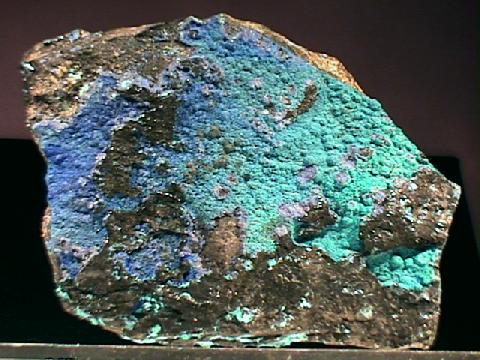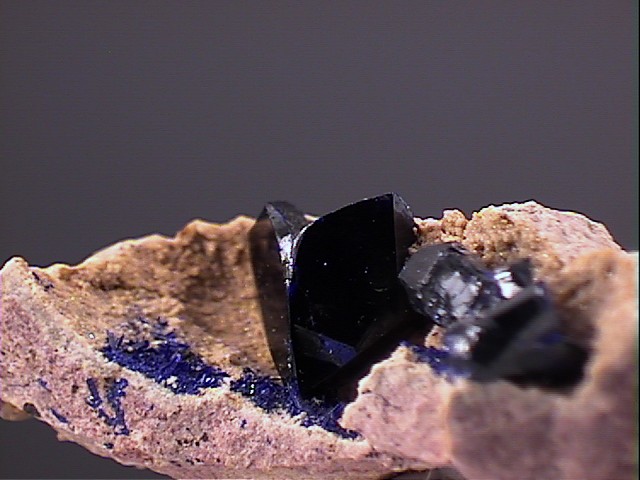Like:
Share:
Azurite is a very popular mineral because of its unparalleled color, a deep blue called "azure", hence its name. Azure is derived from the Arabic word for blue. The color is due to the presence of copper (a strong coloring agent), and the way the copper chemically combines with the carbonate groups (CO3) and hydroxyls (OH). Azurite has been used as a dye for paints and fabrics for eons. Unfortunately, at times its color is too deep and larger crystals can appear black. Small crystals and crusts show the lighter azure color well. Azurite is often associated with its colorful close cousin, malachite. Green malachite is closely associated with azurite in many ways. Not only do they frequently occur together (pictured above), they also have very similar formulae. Malachite can also replace azurite, making a pseudomorph, or an exact copy of an azurite crystal (only now instead of being blue, it would be green). Compare their formulas: Malachite's formula: Cu2(CO3)(OH)2 Azurite's formula: Cu(OH)2-2(CuCO3) Malachite's formula: Cu(OH)2-CuCO3 Notice the different amounts of CuCO3 in the two formulas. The azurite seems to have an extra CuCO3, but the transformation could be explained by an addition of an extra Cu(OH)2 to azurite's formula to make two malachites as in the following equation:
The oxidation is persistent and actually ongoing, although very slow. Azurite paints made centuries ago have undergone the transformation much to the imagined horror of artists whose paintings of beautiful blue skies now have a most unusual green hue! Thankfully for mineralogists and collectors, this transformation is one of the most asthetically pleasing in the mineral kingdom. Although the malachite may soften the sharpness of the azurite crystal, it generally leaves the specimen intact and a whole range of transformations from pure azurite to pure malachite can be obtained. There really is no comparison to any other mineral to mineral transformation in terms of overall beauty. Azurite is used in jewelry and for dyes as mentioned above. It is also an unimportant ore of copper, although its significance has been more impressive in the past. It is still considered a minor ore of copper; mostly because it is found associated with other more valuable copper ores. Fine crystal clusters, nodular specimens, and interesting and beautiful combinations with malachite are important pieces in anyone's mineral collection. The magnificent color of azurite is worth mentioning again as it truly is a one-of-a-kind in the mineral world. Azurite is one of those classic minerals. PHYSICAL CHARACTERISTICS:
|
 Amethyst Galleries' Mineral Gallery MINERALS |

$ 120.00


$ 23.00

azu-2 ($ 23.00)

$ 52.00

azu-3 ($ 52.00)

$ 25.00

azu-4 ($ 25.00)

$ 50.00

azu-8 ($ 50.00)

$ 26.00

azu-9 ($ 26.00)

$ 21.00

azu-12 ($ 21.00)

$ 24.00

azu-14 ($ 24.00)

$ 21.00

azu-16 ($ 21.00)

$ 24.00

azu-18 ($ 24.00)

$ 24.00


azu-19 ($ 24.00)

$ 55.00

azu-22 ($ 55.00)

$ 22.00

azu-23 ($ 22.00)

$ 25.00


azu-24 ($ 25.00)

$ 20.00

azu-25 ($ 20.00)

$ 20.00

azu-26 ($ 20.00)

$ 35.00


azu-28 ($ 35.00)

$ 26.00


azu-29 ($ 26.00)

$ 75.00


azu-30 ($ 75.00)

$ 55.00


azu-31 ($ 55.00)

$ 35.00


azu-32 ($ 35.00)

$ 30.00


azu-33 ($ 30.00)

$ 300.00



$ 40.00

azu-35 ($ 40.00)

$ 35.00


azu-36 ($ 35.00)

$ 225.00


azu-37 ($225.00)

$ 21.00

azu-38 ($ 21.00)

$ 35.00

azu-39 ($ 35.00)

$ 60.00

azu-40 ($ 60.00)

$ 45.00


azu-41 ($ 45.00)

$ 55.00


azu-42 ($ 55.00)

$ 70.00


azu-43 ($ 70.00)

$ 35.00


azu-44 ($ 35.00)

$ 80.00


azu-45 ($ 80.00)

$ 30.00

azu-46 ($ 30.00)

$ 32.00

azu-47 ($ 32.00)

$ 145.00

azu-48 ($145.00)

$ 90.00

azu-49 ($ 90.00)

$ 25.00


azu-50 ($ 25.00)

$ 50.00

azu-51 ($ 50.00)

$ 65.00

azu-52 ($ 65.00)

$ 45.00

azu-53 ($ 45.00)

$ 300.00


azu-54 ($300.00)

$ 28.00

azu-55 ($ 28.00)

$ 26.00

azu-56 ($ 26.00)

$ 25.00

azu-57 ($ 25.00)

$ 25.00

azu-60 ($ 25.00)

$ 27.00

azu-61 ($ 27.00)

$ 25.00

azu-62 ($ 25.00)

$ 225.00



$ 25.00

azu-64 ($ 25.00)

$ 200.00



$ 180.00



$ 160.00



$ 140.00



$ 120.00


azu-69 ($120.00)

$ 120.00


azu-70 ($120.00)

$ 90.00


azu-71 ($ 90.00)

$ 60.00


azu-72 ($ 60.00)

$ 30.00

azu-73 ($ 30.00)

$ 60.00


azu-74 ($ 60.00)

$ 30.00

azu-76 ($ 30.00)

$ 45.00


azu-77 ($ 45.00)

$ 30.00

azu-78 ($ 30.00)

$ 120.00


azu-79 ($120.00)



